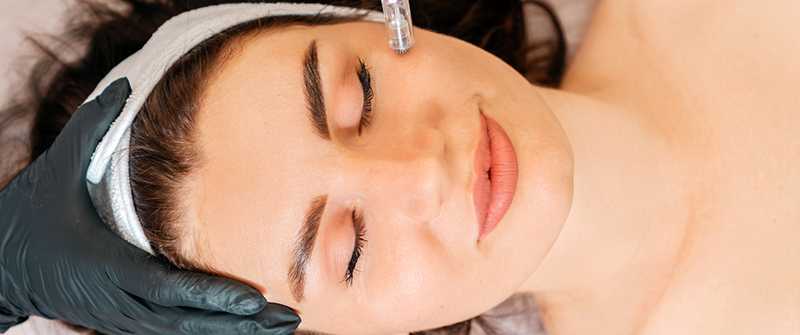Exploring The Benefits & Side Effects of Microneedling
Microneedling is a popular skin care technique that some dermatologists and clinicians use to treat certain skin conditions, and to improve the general appearance of the skin.

But before anyone schedules a microneedling procedure for themselves, it’s good to know about how the procedure works, the exact skin benefits you’re signing up for, as well as the potential risks to be aware of.
So without further ado, let’s talk microneedling and explore the amazing benefits and potential side effects of this minimally invasive skin treatment.
Firstly: How exactly does microneedling work?
Let’s start with collagen. Collagen is an essential protein that plays a fundamental role in keeping the skin looking youthful, smooth and firm. Unfortunately, we gradually lose collagen as we age - but treatments like microneedling can help to amp up our body’s production of it again.
The microneedling method involves using either a pen-shaped or rolling tool containing multiple tiny, sterile needles to puncture the skin, causing a safe degree of physical trauma that works to stimulate the rebuilding of the deeper layer of skin, while of course, encouraging the skin to produce more collagen and elastin.
A typical procedure microneedling procedure will take around 10-20 minutes, depending on the size of the area being treated. Most patients will require around 4 to 6 treatment sessions for the most noticeable results.
The beautiful benefits of microneedling
Professional microneedling is believed to help address a number of skin-related concerns, including the following:
- Fine lines and wrinkles
- Enlarged pores
- Acne scarring/ general skin scarring
- Skin pigmentation issues
- Stretch marks
- Alopecia
- Rosacea
- Loose skin that commonly occurs after dramatic weight loss or liposuction procedures
Microneedling is also used to aid in skin rejuvenation, and is thought to noticeably improve skin texture after several sessions.
Additionally, skin care professionals can use microneedling to administer or deposit certain medications such as topical tretinoin (retin-A) or vitamin C deeper into the skin. This allows the medication to better penetrate the skin and deliver a more effective treatment.
The minor risks of microneedling
While the medical community generally considers microneedling treatment to be both safe and effective, there are still some risks to be aware of.
Skin damage is the most common potential side effect of microneedling, although it is most often temporary and therefore not a major concern for most patients. This damage may include issues like bleeding, bruising, redness, peeling, itching and tightness - but again, will generally resolve within a few days or weeks following microneedling treatment.
Less common potential side effects of microneedling include skin stinging or itching with the application of cosmetics or other skin care products or topical creams, in addition to the appearance of dark and/or light spots on the skin, lines, a cold sore flareup, swollen lymph nodes and/or infection of the skin.
Fortunately, however, it is easy to avoid a side effect like infection by simply choosing a trained professional to carry out the procedure, and by following the proper sanitary skin care instructions following treatment.
What to know about home microneedling
While it is always recommended to see a professional to perform microneedling, there are also home microneedling devices on the market. You may have seen them in stores, or may even own one yourself!
While these devices are much less costly than a session with a trained clinician, it’s important to note that there are key differences between these at-home tools and the ones used by professionals.
Home microneedling devices contain needles that are shorter and more blunt than professional-grade devices. They are not designed to effectively penetrate the skin, and therefore will not be as uncomfortable as professional microneedling tools. But as the saying goes - ‘no pain, no gain’! Well, we’re not saying you won’t see any results with at-home treatment, but it won’t be comparable to the degree of effectiveness that professional microneedling sessions can provide.
Furthermore, home microneedling devices are more challenging to clean properly - and inadequate sanitation can greatly increase the risk of infection. At the end of the day, scheduling your microneedling treatments with a certified professional is the wisest choice if you want to experience noticeable skin improvement with minimal risk.
Am I a candidate for professional microneedling?
Many people who suffer from some or all of the aforementioned skin concerns are great candidates for microneedling treatment. However, there are people who should certainly avoid this procedure, including those with the following conditions:
- Active acne
- An active skin infection
- Keloid scarring
- A skin type that is not deemed stable
Speaking with one of our skin care specialists during your consultation will help you to determine whether microneedling can be a safe treatment option for you!
Ready to uncover a more flawless and youthful complexion with microneedling in Mississauga?
Let us help you prick your way to perfection with professional microneedling treatment at Beauskin!
Reach out to our team of skin care experts today to schedule your microneedling consultation and appointment, or to learn more about this popular skin treatment.
We look forward to hearing from you. :)
